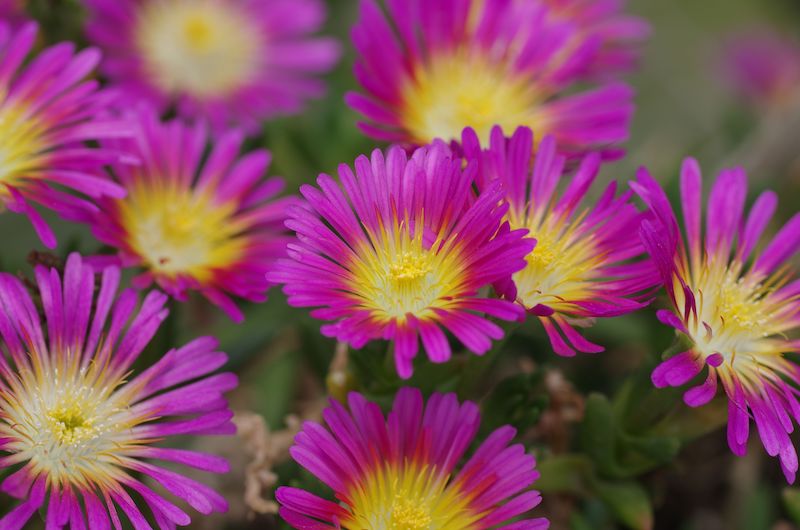Growing Ice Plant
Succulents thriving in hot, dry climates with life-or-death aversions to too much moisture called ice plants. Is this really true? Yes, as perplexing as it may sound, ice plants, or most members of the Aizoaceae family, are plants growing in arid climates, possessing tiny features that uniquely mirror delicate ice crystals glistening in the sun. One particular genus called Delosperma consists of flowering plants native to South Africa. These ice plants feature 2-inch, daisy-like florets in orange, bubblegum pink, lavender, crimson, lemon yellow, and orange sherbet hues, blooming in spring and summer.

Heat tolerant, drought tolerant, and mainly disease resistant, these compact fast-growing, herbaceous perennials reach maximum heights of only 3 to 6 inches and spreads of 12 -24 inches. With their showy flowers and unique foliage, these plants are excellent choices to use as ground cover in landscapes in dry climates. Low maintenance and easy to care for, Delosperma also thrives in containers, adding punches of vibrant color to desks, patios, and porches. Cold hardy in zones 5 to 9, these succulents provide interest throughout the year.
Planting Ice Plant
Proper light, soil, and water conditions are key to maximizing what you get from your ice plant. In warmer areas, you can plant this fast-growing selection in autumn, as it will have adequate time to establish itself before winter. In cooler climates, however, plant ice plants earlier in July. Choose a location that gets full sun. Ice plant typically needs 6 to 8 hours of full sun to produce its beautiful florets. While this succulent tolerates poor substrate, the soil must be sandy and drain well. Avoid planting in clay soil. However, if that’s your only choice, amend the soil heavily with fine grit or sand. Ice plants prefer soil pH that is slightly acidic to slightly alkaline. Dig a hole about the same size as the root ball and backfill. Space plants 12 to 18 inches apart. Plant this beauty with blue fescue, coreopsis, and lamb’s ear.

Watering Ice Plant
This herbaceous perennial will die from root rot if maintained in constantly moist soil. As a result, always conduct a moisture check before watering. Only water if the top one inch of soil is dry. If not, then wait two or three days to conduct another moisture check. Water deeply every one or two weeks, depending on the temperature and the amount of rainfall. In colder climates, stop watering as the growing season comes to an end. The goal is to harden off this perennial’s succulent leaves prior to winter.
Fertilizing Ice Plant
Tolerating poor soils, this succulent is not typically a heavy feeder; however, to support growth, apply a balanced (10-10-10), slow-release fertilizer at the time of planting or shortly after if needed. To encourage ice plant to go dormant prior to winter, do not feed it during late summer or autumn months.
Pruning Ice Plant
Trim off any winter-damaged stems in early spring. This showy perennial is a superb option to use as ground cover. Keep in mind that ice plant spreads quickly and can be invasive in warm climates. Trim to maintain its size and keep it in bounds.
Caring For Ice Plant in Pots
Ice plant thrives in containers with proper drainage and soil. Choose a pot 2 to 4 inches larger than the root ball. The pot should have several holes for drainage. Fill the container with a cacti-succulent mix or a typical house potting mix heavily amended with grit or perlite. Repot every 2 to 3 years in a pot that is at least 2 inches larger than the previous container. Ice plant serves as a great spiller in thriller/spiller/filler combinations. Plant it with catmint, phlox, and sedum for a stunning combination.
Winter Care for Ice Plant
Cease fertilizing and reduce watering at the end of summer to decrease the amount of water in the leaves of this semievergreen as fall approaches. Doing so will help to harden it off in preparation for the winter months. If heavy, cold rain is in the winter forecast, then cover this perennial with some type of cloth such as burlap to protect its roots and foliage from rot.
 |
Author Suellen Barnes - Published 2-28-2023 |
